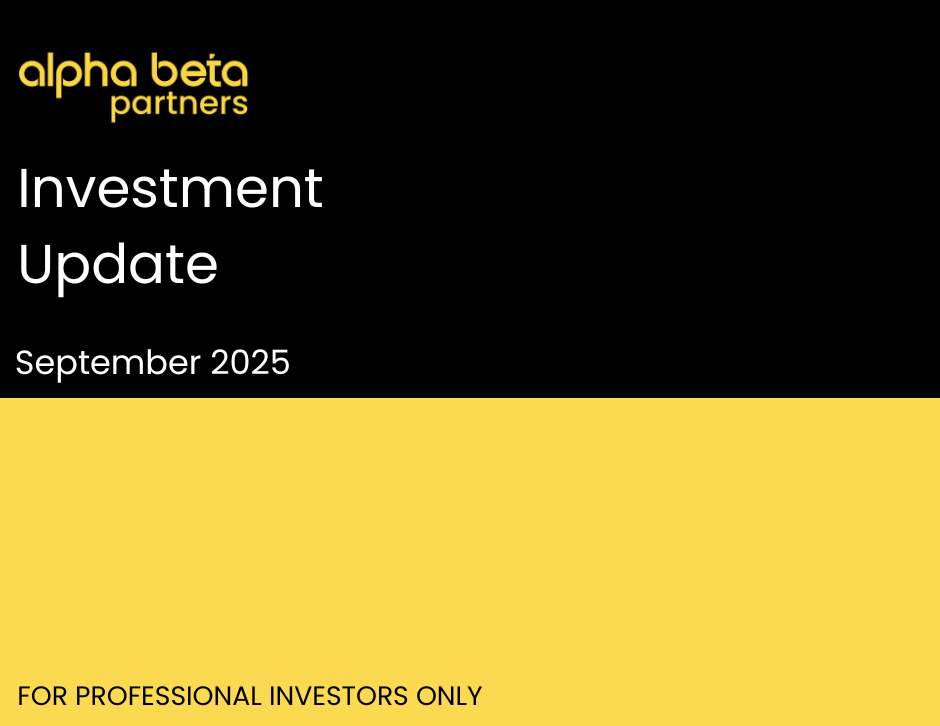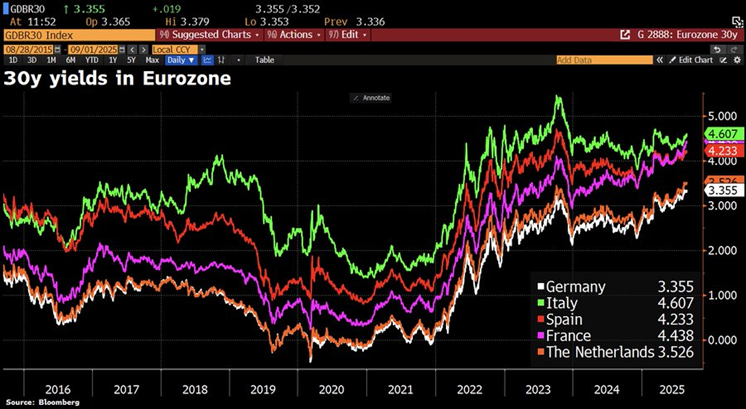Investment Update September 2025
- ABP Team

- Sep 2, 2025
- 7 min read
Updated: Sep 4, 2025

Key Highlights:
US Producer Price Inflation rose to 3.3%, marking the largest monthly increase since March 2022.
The S&P 500 posted 1.9% growth, led by technology and AI earnings, while the Dow Jones remained volatile.
The VIX volatility index rose, the 10-year Treasury yield stayed near 4.25%, and the US dollar weakened.
US tariffs generated $31bn in August, with an effective rate of 12%, largely borne by consumers and companies.
At Jackson Hole, Jerome Powell highlighted persistent inflation, labour fragility, and restrictive interest rates, with markets pricing potential cuts from September.
The accumulation of a colossal debt mountain signalled a period of fiscal dominance, with longer-dated yields rising across developed markets.
Gold and silver continue to glister, while liquid alternatives and short-dated debt are favoured over long-dated fixed income.
UK Q2 GDP grew 1.2% annualised, inflated by government spending while consumption, trade, and capital formation weakened.
Andrew Hunt Economics described the UK as already in a “Debt Doom Loop”, with debt interest expense growing twice as fast as nominal GDP.
The FTSE 100 reached a record 9,321.40, up 12.47% year-to-date, despite UK inflation rising to 3.6% and a Bank of England rate cut to 4.00%.
The EURO STOXX 50 declined 0.76% to 5,352 points over the month, though still 7.95% higher year-on-year, as higher bond yields pressured banks.
China’s CSI 300 surged nearly 22% from April lows, while the Shanghai Composite gained over 6.7%.
Japanese equities gained, with the Nikkei 225 up 4.01% and the Topix rising 4.49%, supported by the resolution of US–Japan tariff negotiations, a weaker yen, and strong earnings.
At portfolio level we avoided making changes during August; short-dated fixed income is positioned to benefit from lower rates, and 50% currency hedging on US equities remains in place against a structurally weaker dollar.
August is characteristically a quiet month. Seasonally, we are now in the weakest part of the year (until mid-October). As always, the qualifier for these indicators is that they work ‘all else being equal’, and in 2025, nothing is particularly equal! We saw signs of US inflation bubbling under, in the form of Producer Price Inflation hitting 3.3% and delivering the biggest monthly incrrease since March 2022.
In August, US stock markets reached new highs with the S&P 500 posting 1.9% growth, driven by strong corporate earnings—particularly in the technology and AI sectors—and a rebound in investor sentiment following earlier trade tensions. The Nasdaq posted solid gains, with mega-cap tech firms like Meta, Alphabet, and Amazon leading the charge. Despite this rally, the Dow Jones Industrial Average experienced notable volatility due to concerns over new tariffs, labour market weakness, and Federal Reserve policy uncertainty. GDP levels printed notably higher than the previous month and ISM (Institute of Supply Management) data for Services sectors continued its robust performance. In contrast, the VIX volatility index ended the month higher. The dollar weakened further, boosting foreign investment and aiding exporters, while bond markets stabilised amid growing expectations of a rate cut in September. The 10-year Treasury yield stands at around 4.25%, which remain stubbornly higher than Treasury Secretary Mr Scott Bessent would like.
US tariffs raised $31bn for August – a handy revenue stream indeed, but not one that can meaningfully dent the $37 trillion debt. The effective tariff rate is 12%, which appears to be almost exclusively borne by US consumers/companies. Import prices have by and large not fallen, apart from those notably from Japan whose Yen devaluation has helped them no end. US judges ruled that President Trump acted beyond his presidential powers in the establishment of the international trade tariff framework. Tariffs remain in situ until the Supreme Court opines in October, which we expect to rule in favour of President Trump.
The annual Jackson Hole symposium for central bankers offered some interesting inputs this year. Notably, Federal Reserve Chair Jerome Powell flagged persistent inflation and labour market fragility from weak demand, low supply, and reduced immigration. He deemed rates restrictive, hinted at policy adjustment, and markets priced cuts in interest rates from September. A more qualitative approach to employment will be devised (stimulated by AI factors on the labour market) and a broader measure for inflation will be deployed.

Source: AP News Article, 23 August 2025 One disturbing trend across pretty much all developed markets is the ongoing accumulation of a colossal debt mountain. The debt accumulation brings with it economic policies supportive of debt management – in essence a period of fiscal dominance is with us. Consequently, longer dated government bond yields have pushed higher almost without exception. This signifies higher borrowing costs for longer dated debt and implies the market has lower confidence in the ability for repayment. We have certainly seen a growing trend towards currency debasement across lender nations which supports the market doubts. Inflation appears to be trending towards 3% or higher in the medium term. Injections of liquidity remain an ever-present feature to stimulate economies and to provide sufficient funding to allow for debt refinancing to take place. The chart shows longer dated yields on the rise in the Eurozone. The same is true across all developed markets.

Source: Bloomberg, 1 September 2025
Against this backdrop portfolio positioning in real assets and “hard money” makes most sense. The attraction of liquid alternatives and short dated debt is preferable to longer dated fixed income whilst gold and silver continue to glister, particularly in the guise of mining equity.
Meanwhile in the UK, in a PR move, Chancellor Mrs. Reeves celebrated second quarter GDP at a higher level than expected – albeit just 1.2% annualised. Not so fast! GDP in the second quarter was bloated by the increase in government spending while consumption, trade, and fixed capital formation slowed down significantly or declined. Business operating surplus declined for a second quarter while taxes continue to rise.
An interesting snapshot from Andrew Hunt Economics: “The UK is already in a Debt Doom Loop”; meaning, total debt interest expense is growing by twice the amount that nominal GDP is expanding. Whenever this has occurred in the past, sterling has fallen sharply. We see no reason to expect a different outcome over the medium term, unless the debt accumulation can be halted.
We remain concerned about the UK debt burden and anaemic growth prospects. That said, the stock market is not the same as the economy. In August, UK markets showed resilience despite economic headwinds. The FTSE 100 climbed to a record high of 9,321.40, marking a 12.47% year-to-date gain, driven by strong performance in energy and financial sectors. Despite inflation ticking up to 3.6% and in a move to stimulate the economy the Bank of England cut rates on 7 August, from 4.25% to 4.00%.
Eurozone markets experienced modest declines amid persistent economic uncertainty and mixed inflation data. The EURO STOXX 50 index fell by 0.76% over the month, closing at 5,352 points on August 29, though it remained 7.95% higher year-on-year. Investor sentiment was weighed down by rising long-dated bond yields, particularly in Germany and France, which pressured bank stocks like Santander and ING. Political tensions in France over budget disputes further widened yield spreads, adding to market volatility. While tech stocks such as SAP and ASML saw declines, defence companies like Rheinmetall posted gains, reflecting sectoral divergence. Overall, Eurozone equities struggled to maintain momentum and in our view the ECB is unlikely to cut interest rates again in the short term.
President Trump’s aggressive tariff policies have created a stronger glue amongst nations comprising the Shanghai Cooperation Organisation (SCO). There are 10 member states in the SCO, notably China, Russia and India. A strategic meeting between President Xi and President Modi is one output.
In August, China's stock markets surged to multi-year highs, driven by a wave of retail investor activity and easing trade tensions with the US. The CSI 300 index rose nearly 22% from its April lows, while the Shanghai Composite gained over 6.7% during the month. The rally was fuelled by Chinese households reallocating record savings—over ¥160 trillion ($22 trillion)—into equities, spurred by low deposit rates and a fear of missing out.
China’s fully automated “dark factories” operate without human presence or lighting, relying on robotics, autonomous vehicles, and machine vision. This manufacturing revolution signals a paradigm shift, reshaping global industrial competition, productivity dynamics, and labour markets in profound and lasting ways. These developments will be deflationary.
China's life expectancy is now approximately the same as the United States when 30 years ago it was 20 years below America. China in the space of one generation has gone from graduating 350,000 university students a year to graduating 12-13 million university students a year. The transformation of the nation has been truly incredible.

Source: Worldometer, August 2025
Japan’s stock markets posted strong gains, with the Nikkei 225 rising 4.01% and the Topix Index up 4.49%, driven by robust corporate earnings and a global equity rally. Market sentiment was buoyed by the resolution of US–Japan tariff negotiations, which eased concerns over trade disruptions and inflationary pressures. Export-related stocks benefited from a weakening yen, while banks and resource sectors outperformed amid rising domestic interest rates. However, political uncertainty following Japan’s upper house elections and fiscal expansion debates introduced volatility, especially in real estate and retail sectors. The Bank of Japan maintained its policy stance, supporting stability as investors looked ahead to further earnings reports and policy signals.
At portfolio level we avoided making changes during August. Our portfolio positioning remains attractive and value accretive for investors. Short dated fixed income holdings will benefit from lower interest rates, due perhaps on 17th September, whilst 50% currency hedging on US equity remains sensible against a backdrop of a structurally weaker dollar. Performance relative to a broad range of peers remains attractive for the year. We continue to monitor alternative asset classes in liquid form which could assist portfolio dynamics. No decisions or timing is currently set, and we will advise if decisions are taken. Based on history, we are due a seasonal pull-back in markets, this could well act as a stimulus for us to amend allocations. We remain vigilant and optimistic for portfolio returns as summer turns to Autumn and with the year-end coming into view.
Written by the Alpa Beta Partners Investment Team
All sources Bloomberg unless otherwise stated.




